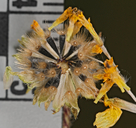notes A fruiting head of Layia gaillardioides, showing the: 1) elongate, black, 'baseball bat'-shaped cypselae (often called 'achenes') with their long, silky, white hairs and their glossy-reddish, 'ball joint'-like bases which attach to the receptacle. Some cypselae from near the center of the disk are pale and narrow (they're presumably not fully-developed, and non-viable for germination).
2) the pappus attached to the top of the cypselae. The pappus consists of both primary bristles that are rusty-colored and 'concave-up' at base, whitish-barbellate apically, and shorter than the cypsela...as well as a basal 'halo' of fluffy, very-narrowly capillary hairs. I'm presuming these fine hairs are what are being referred to by the phrase ''proximally plumose'' used for the pappus in the Jepson eFlora L. gaillardioides description...although I usually think of 'plumose' as referring to pinnately-arranged secondary hairs emanating from a principal bristle.
3) At least one narrow & elongate palea (often called 'chaff scales') is visible (directly below and a bit left of center) as a whitish, longitudinally-veined, and apical-cupped and short-pointed leaf-like structure. Each flower head has a single, peripheral series of paleae (as is typical of tarweeds), and each palea clasps the outer face of an outermost disk fruit....though here the palea has separated from its disk fruit. (Note that each ray fruit is completely enclosed in its associated phyllary in L. gaillardioides...and thus they're not visible here).
4) A few dried and abscised corollas are scattered on top of the head.
Pappus, when present, is helpful in separating various sometimes easily confused species of Layia.
